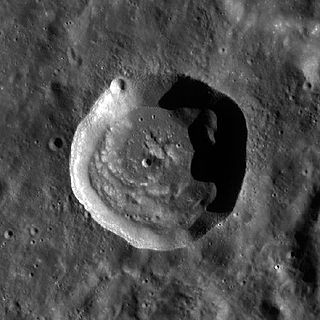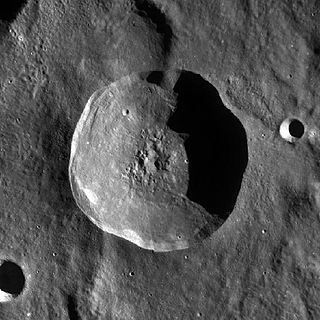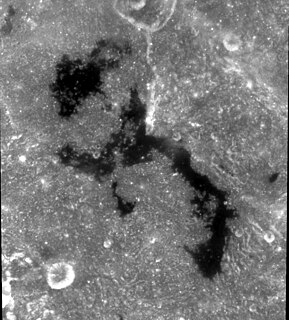
An impact crater is an approximately circular depression in the surface of a planet, moon, or other solid body in the Solar System or elsewhere, formed by the hypervelocity impact of a smaller body. In contrast to volcanic craters, which result from explosion or internal collapse, impact craters typically have raised rims and floors that are lower in elevation than the surrounding terrain. Impact craters range from small, simple, bowl-shaped depressions to large, complex, multi-ringed impact basins. Meteor Crater is a well-known example of a small impact crater on Earth.

Mare Orientale is a lunar mare. It is located on the western border of the near side and far side of the Moon, and is difficult to see from an Earthbound perspective. Images from spacecraft have revealed it to be one of the most striking large scale lunar features, resembling a target ring bullseye.

Nicholson is a lunar impact crater located at the western limb. In this position it is subject to libration, which can limit observation. The crater is also viewed at a very oblique angle, so it is seen from the side when observed from the Earth. It is an irregular, somewhat pear-shaped formation that has an uneven rim due to its location amidst rugged ground. The rim is sharp-edged and the inner wall varies in thickness, being narrower along the northern side and wider at the southern end. The interior floor is rough, small and uneven, with no impacts of significance. There is a small central ridge.

Montes Alpes is a mountain range in the northern part of the Moon's near side. It was named after the Alps in Europe; the name was confirmed by the International Astronomical Union in 1935. It lies between the selenographic coordinates latitudes 52.81°N and 42.04°N, and longitudes 5.6°W and 3.22°E. The range thus crosses the lunar prime meridian, and is partially illuminated and partially in shadow during first and last quarters. The center of the range is at 48.36°N, 0.58°W, and has a diameter of 334 km.

Drude is a lunar impact crater that lies on the far side of the Moon, in the rugged Montes Cordillera range that forms the outer ring around the Mare Orientale impact basin. It is located just behind the west-southwest limb, and this area is sometimes brought into sight from Earth during favorable librations. However, even at such times, the crater is viewed from the edge and little detail can be seen.

Lallemand is a small lunar impact crater that lies near the western limb of the Moon, in a region where the visibility is affected by libration effects. Because of its location, when viewed from the Earth the crater is viewed nearly from the side, limiting the amount of detail that can be seen. It lies in the northeast part of a mountain range named the Montes Rook that forms a ring around the enormous Mare Orientale impact basin. To the northeast is the Lacus Autumni and to the northwest lies the Lacus Veris, both forming small lunar maria along the sides of the range.

Focas is a small lunar impact crater that lies on the far side of the Moon, just past the southwestern limb. In this location the crater is occasionally brought into view due to libration, but not much detail can be seen because the crater is viewed from the side.

Chant is a lunar impact crater that is located on the far side of the Moon, behind the southwest limb as seen from the Earth. It lies within the southwestern part of the blanket of ejecta surrounding the Mare Orientale, beyond the Montes Cordillera mountain ring. To the west-northwest is the large walled plain Blackett. Southward is the crater Mendel.

Couder is a small lunar impact crater that is located just behind the western limb of the Moon, in a region of the surface that is brought into view during favorable librations. It lies on the inner foothills of the Montes Cordillera, a ring-shaped mountain range that surrounds the Mare Orientale impact basin.

Montes Cordillera is a mountain range on the Moon. This feature forms the outer wall of peaks that surround the Mare Orientale impact basin, the inner ring being formed by the Montes Rook. The center of the range is located at selenographic coordinates 17.5° S, 81.6° W, and the diameter is 574 km (357 mi).

Eichstadt is a lunar impact crater that is located in the eastern section of the Montes Cordillera range that encircles the Mare Orientale impact basin. It lies toward the southwestern limb of the Moon, and so appears oblong when viewed from the Earth due to foreshortening. Over 200 kilometers to the east of Eichstadt are the craters Darwin and Lamarck, and to the south is Krasnov.

Wright is a lunar impact crater that is located near the western limb of the Moon. It lies on the irregular plain between the Montes Cordillera and Montes Rook, two ring-shaped mountain ranges that surround the Mare Orientale. Just to the southeast of the crater is the slightly larger crater Shaler. To the north of Wright is the crater Pettit.

Chalonge is a lunar impact crater that is located on the far side of the Moon. It lies to the southwest of the larger crater Lewis, in the outer skirt of ejecta that surrounds the Mare Orientale impact basin. To the southeast are the Montes Cordillera, a ring of mountains that encircle the Mare Orientale formation.

Steklov is a lunar impact crater on the far side of the Moon, past the southwestern limb. It lies in the outer skirt of ejecta from the Mare Orientale impact basin, just to the southwest of the Montes Cordillera ring of mountains. About four crater diameters to the southwest is the slightly smaller crater Chant.

Guthnick is a lunar impact crater that lies on the far side of the Moon's surface from the Earth. However, it is located in the part of the far side that is sometimes brought into sight of the Earth due to libration, although it can only be seen at a low angle and during favorable lighting conditions. Guthnick is situated in the southern portion of the huge skirt of ejecta that surrounds the Mare Orientale impact basin. Less than a crater diameter to the northwest is the slightly larger crater Rydberg. To the south-southwest is the small Andersson.

Lacus Autumni is a region of lunar mare that lies near the western limb of the Moon. Along this side of the lunar surface is a huge impact basin centered on the Mare Orientale. Two concentric mountain rings surround the Orientale mare, the inner ring being named Montes Rook and an outer ring called the Montes Cordillera. Lacus Autumni lies in the northeastern quadrant of the gap between these two mountain rings. This section of the lunar surface is difficult to observe directly from the Earth.

Lacus Veris is a small lunar mare on the Moon. In selenographic coordinates, the mare centered at 16.5° S, 86.1° W and is approximately 396 km long. The mare extends along an irregular 90° arc from east to north that is centered on the Mare Orientale, covering an area of about 12,000 km2. Author Eric Burgess proposed this mare as the location of a future manned lunar base, citing a 1989 study performed at the NASA Johnson Space Center.

The Tolstoj quadrangle in the equatorial region of Mercury runs from 144 to 216° longitude and -25 to 25° latitude. It was provisionally called "Tir", but renamed after Leo Tolstoy by the International Astronomical Union in 1976. Also called Phaethontias.

The Beethoven quadrangle is located in the equatorial region of Mercury, in the center of the area imaged by Mariner 10. Most pictures of the quadrangle were obtained at high sun angles as the Mariner 10 spacecraft receded from the planet. Geologic map units are described and classified on the basis of morphology, texture, and albedo, and they are assigned relative ages based on stratigraphic relations and on visual comparisons of the density of superposed craters. Crater ages are established by relative freshness of appearance, as indicated by topographic sharpness of their rim crests and degree of preservation of interior and exterior features such as crater floors, walls, and ejecta aprons. Generally, topography appears highly subdued because of the sun angle, and boundaries between map units are not clearly defined.

A multi-ringed basin is not a simple bowl-shaped crater, or a peak ring crater, but one containing multiple concentric topographic rings; a multi-ringed basin could be described as a massive impact crater, surrounded by circular chains of mountains. As such, a multi-ring basin slightly resembles a bull's-eye, may have an area of many thousands of square kilometres.



















